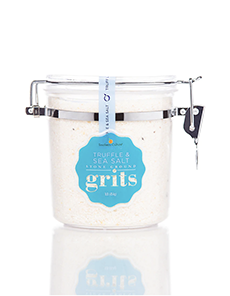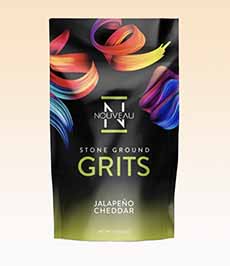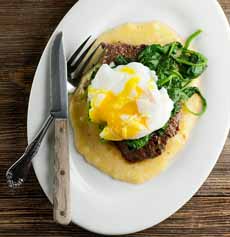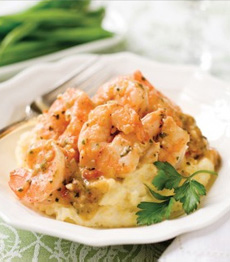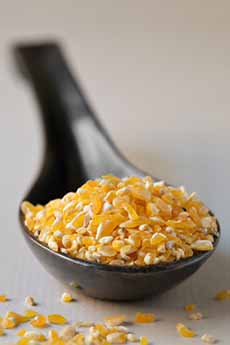Truffle Grits & Ways To Serve Grits For Breakfast, Lunch & Dinner
|
|
These stone-ground truffle grits (photo #1) are a tasty gift packaged in a reusable canister. Created by Chef Ebony Austin, owner of Atlanta’s Nouveau Bar & Grill, the premium white corn grits, from corn grown in the Georgia mountains, are blended in small batches with truffle powder and sea salt. They’re ready to make a delicious side for breakfast, lunch, or dinner. Bonus: Grits are gluten-free. Chef Austin has also packaged gifts in dramatic envelopes (photo # 2): in Original, Garlic & Herb, and Jalapeño & Cheddar, via Shopify. Whether canister or envelope, the grits are packaged beautifully for gifting or home use. > For the canister-packaged truffle grits, head to SocuKitchen.com. > For the three flavors in envelope packaging, head to Shopify. > Check out the grits recipes below. Grits can be ground into fine, medium, or coarse textures, which impact the cooking time. GRITS: A porridge made from cornmeal boiled with milk or water. Grits are traditionally served as a breakfast dish, as part of a dinner entrée (shrimp and grits is a popular pairing), as pudding, and as a side dish, where it also can be shaped into squares and fried. Grits can be prepared either savory or sweet, with savory seasonings being more common. Corn is a New World grain, and the dish originated in the Southern U.S.*; it is now found nationwide. Grits are similar to other thick, maize-based porridges from around the world, such as polenta (Italy) and mieliepap (South Africa). Traditionally, grits were made with dried hominy (see next definition), which is corn that has been treated with an alkali solution. However, you can also find grits that are simply coarsely ground or stone-ground cornmeal. Grits are made from both yellow and white corn. Historically, white corn was popular in the port cultures of the South (Charleston, New Orleans, Savannah, Wilmington) that were settled by Europeans who had a preference for white milled flour. Moving inland through the rural American South, yellow corn and grits predominated. White corn has more pronounced mineral and floral nuances; yellow corn is more robust with citrus flavor at the back of the palate. > The difference between grits and polenta. HOMINY GRITS: Hominy grits are a type of coarsely-ground grits made from hominy, which is corn that has been treated with an alkali in a process called nixtamalization. Hominy grits are made by soaking dried corn kernels in the alkali solution to remove the outer hulls. The soaked corn kernels are then dried and ground into grits. They are typically ground several times into uniform small pieces, about 1/16th to 1/20th of an inch across. Hominy grits generally have a finer texture than stone-ground grits. The preferred texture is a matter of individual choice. In the Charleston, South Carolina, area, cooked hominy grits are called “hominy” and uncooked grits are called “grist.” The word “grits” is derived from the Old English word grytt, meaning coarse meal [source]. HOMINY Hominy is nixtamalized corn, a food made by soaking dried whole corn in an alkali solution to remove the germ and hull. White or yellow corn kernels are added to scalding water mixed with the chemical (alkali) solution, such as mild lye or slaked lime. The soaking forces the kernel to expand so the hull and germ split, and the kernels can be easily removed. The kernels can then be boiled whole, creating a soft puffy food, or ground into grits. Hominy has other uses, too. For example, in Mexican cuisine, it is finely ground to make masa harina (corn flour), which is then turned into tacos, tamales, tostadas, etc. Hominy is the Colonial English spelling of the sound of the oral Native American word for corn. “Hominy” is a shortened version of the old Carolina term for whole corn, “hominy grist.” *Native Americans and Mesoamericans made the first porridges from cornmeal. |
|
|
|
||
